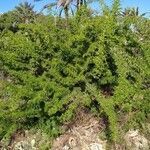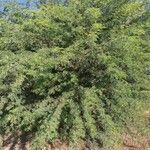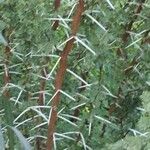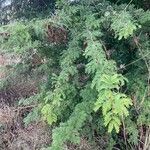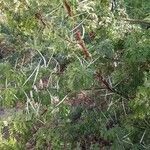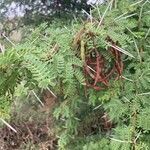Multi-stemmed shrub or (according to Ross 1979) a tree to 12 (–20) m high, crown ±rounded or flat-topped. Bark brown to black and rough or greyish and smooth. Branchlets glabrous, dark brown, lenticellular. Stipular spines 5.5–12 cm long, rigid, patent, straight, terete, white. Leaves arising from within axil of spines and also from branch immediately above spines, sometimes grouped 2 or 3 together; petiole 5–10 mm long, channelled above, glabrous, with a quite prominent gland (1–1.5 mm long) on adaxial surface near base; rachis 15–30 mm long, glabrous, channelled above, with a small gland at base of pinnae; pinnae 2 or 3 pairs (1–7 pairs, in litt.), (15–) 20–40 mm long; pinnules 6–12 pairs, narrowly oblong to oblong-oblanceolate, 3.5–8 mm long, 1–2.5 mm wide, glabrous, green, concolorous, obscurely 1-veined, sometimes with small gland at base of some pairs. Inflorescences (based on Ross 1979) single or fascicled; peduncles 7–24 (–40) mm long, with involucel of bracts ⅓–¾ from the base; heads globular, bright yellow. Pods (based on Ross 1979) linear, ± constricted between the seeds, often distinctly moniliform, (4–) 5–1.5 (–21) cm long, 5–7 (–11) mm wide, dehiscent, normally curved, longitudinally veined, glabrous or sometimes tomentulose. Unless otherwise stated the above description is based on the few sterile specimens in Australian herbaria. This species is comprehensively described in Ross (1979).
An evergreen shrub or small tree. It grows to 5 m tall and 3 m wide. It can be 15 m tall. The stem is erect. It has spines. The spines are silvery white with a black tip. The spines or thorns can be 7 cm long. The bark is rough and grey-black. The bark peals off to show a rust red colour underneath. The branches are spreading. The leaves (phyllodes) are grey and divided twice. They are 10 cm long. There are 8-20 pairs of leaflets. The flowers are pale yellow. They have a sweet smell. They flowers occur in dense clusters. The pods are 12.5 cm long and narrow. The pods curve to a sickle shape. When ripe they are dark brown.
Shrub or tree, 3-5(22) m high, trunk up to 0.75 m in diam. Bark dark brown to black, coriaceous, fissured. Branches dark olive-brown when young, conspicuous whitish lenticels, glabrous. Leaves bipinnate, rachis 5-38 mm long, pinnae 2-6 pairs, each with 5-15 leaflet pairs. Spines 2, prominent, stipular, straight, white, 25-100 mm long. Flowers in globular heads grouped in clusters of 1-7, bright yellow. Pod pale brown, linear-oblong, 50-105 x 5-7 mm, slightly curved to sickle-shaped, thinly woody, constricted between seeds, glabrous, dehiscent. Flowering time Oct.-Feb.
Tree or shrub, up to 22 m high; young branchlets glabrous. Leaves green or dark green, with leaflets 6-15(-22) pairs per pinna, 1-5 mm wide; stipules spinescent, 40-70(-100) mm long, sometimes greatly elongated up to 250 mm long; conspicuous gland present on petioles. Flowers: inflorescences capitate; corolla bright yellow; Nov.-Mar. Pods slightly to strongly falcate, constricted between seeds, but not jointed, longitudinally dehiscent, reddish to grey-brown, glabrous.
Tree or rarely a shrub, up to 15 m tall, young branches conspicuously rusty red, bark rough, dark red-brown. Leaves twice pinnate, with 2-7 pairs of pinnae, each with 8-20 pairs of oblong leaflets, stipules of straight, stout, white spines with dark tips. Flowers in globose heads, deep golden-yellow, sweetly scented. Pod slender, sickle-shaped, slightly constricted between seeds, compressed, glabrous, thinly woody.
Tree or shrub, up to 22 m high. Young branchlets glabrous. Stipules spinescent in pairs, 40-70(-100) mm long. Leaflets 6-15(-22) pairs per pinna, 1-5 mm wide. Flowers in round heads. Pods slightly to strongly falcate, constricted between seeds but not jointed, dehiscent. Flowers bright yellow.
Armed shrub or small tree to 12 m, spines straight. Leaves bipinnate. Flowers in globose heads, bright yellow. Pods flat, falcate, constricted between seeds.
